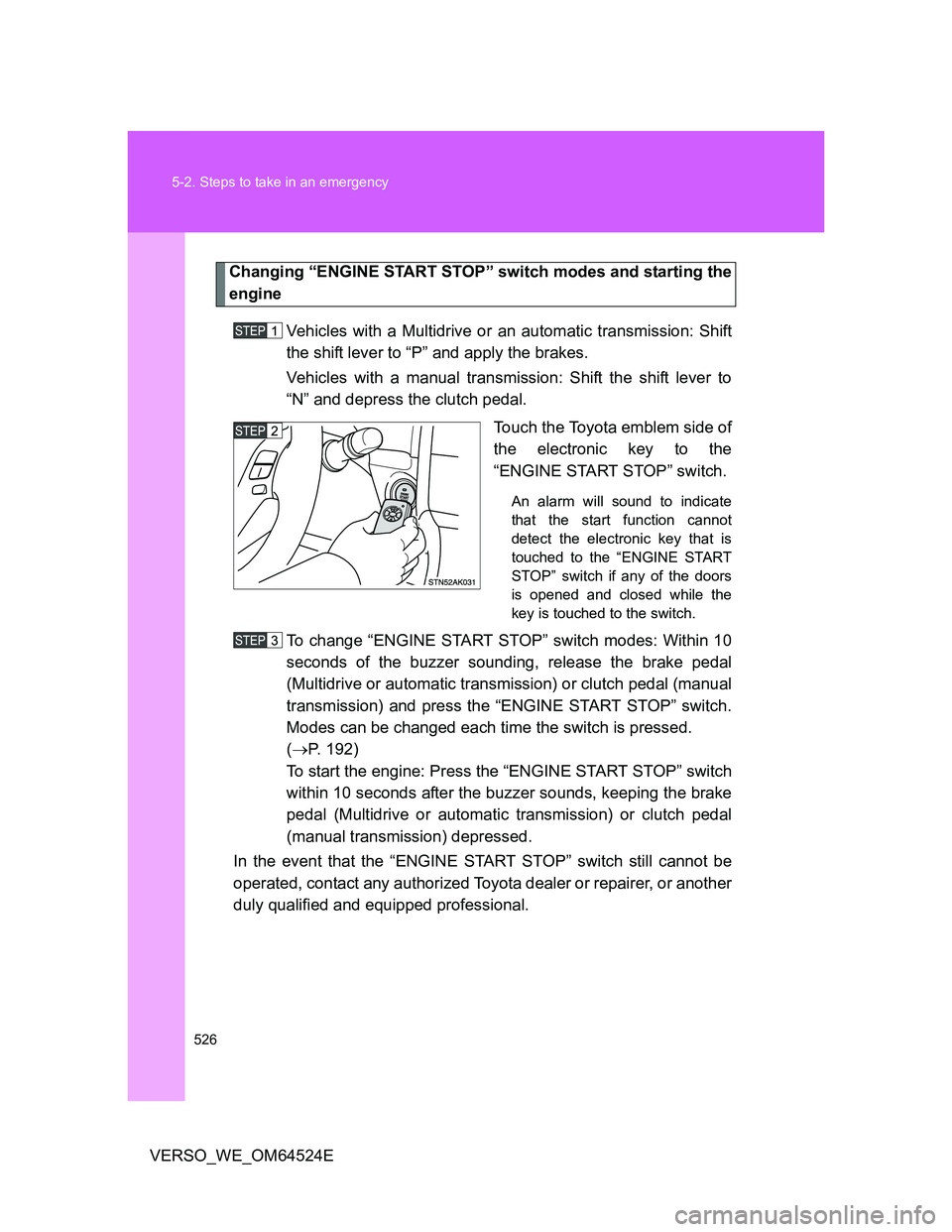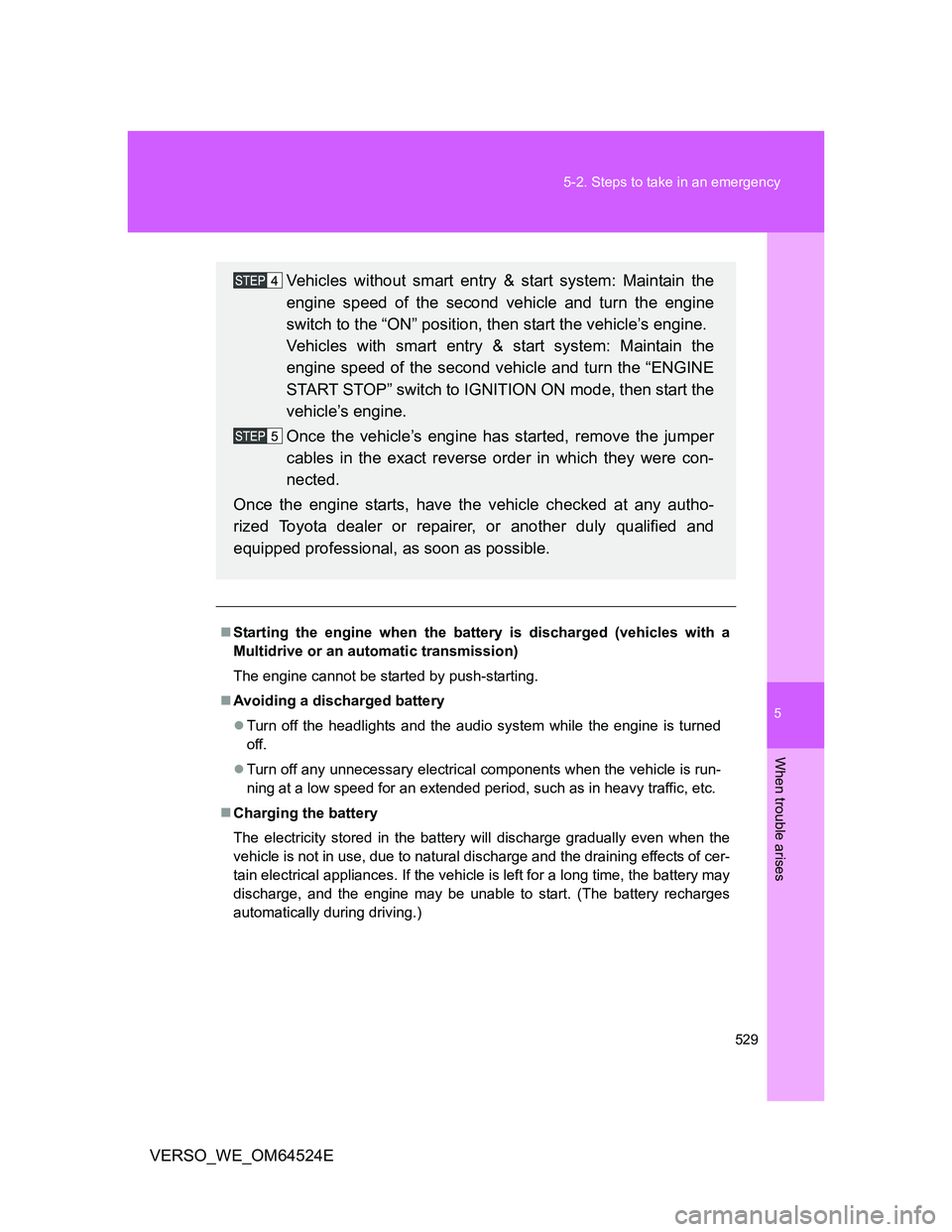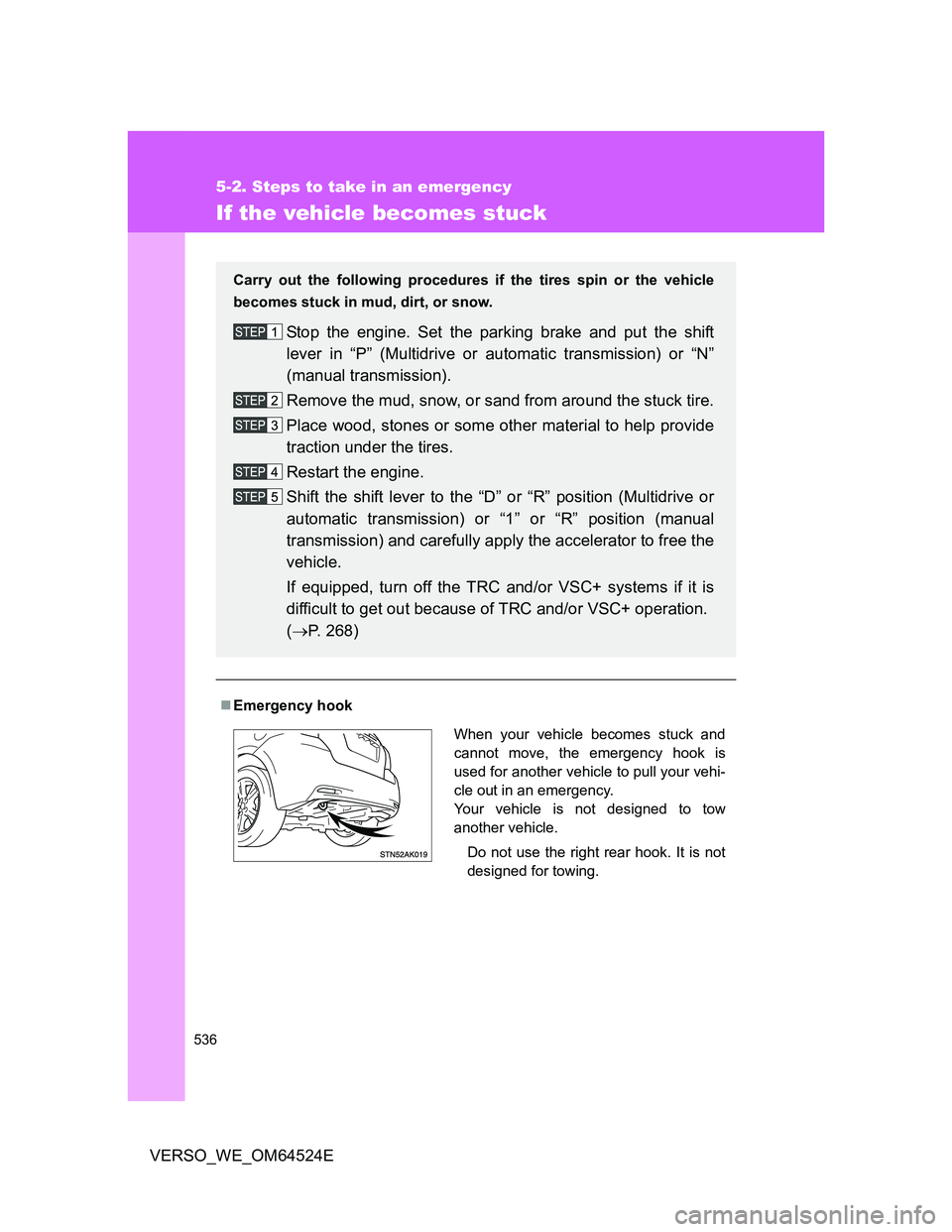Page 526 of 588

526 5-2. Steps to take in an emergency
VERSO_WE_OM64524E
Changing “ENGINE START STOP” switch modes and starting the
engine
Vehicles with a Multidrive or an automatic transmission: Shift
the shift lever to “P” and apply the brakes.
Vehicles with a manual transmission: Shift the shift lever to
“N” and depress the clutch pedal.
Touch the Toyota emblem side of
the electronic key to the
“ENGINE START STOP” switch.
An alarm will sound to indicate
that the start function cannot
detect the electronic key that is
touched to the “ENGINE START
STOP” switch if any of the doors
is opened and closed while the
key is touched to the switch.
To change “ENGINE START STOP” switch modes: Within 10
seconds of the buzzer sounding, release the brake pedal
(Multidrive or automatic transmission) or clutch pedal (manual
transmission) and press the “ENGINE START STOP” switch.
Modes can be changed each time the switch is pressed.
(P. 192)
To start the engine: Press the “ENGINE START STOP” switch
within 10 seconds after the buzzer sounds, keeping the brake
pedal (Multidrive or automatic transmission) or clutch pedal
(manual transmission) depressed.
In the event that the “ENGINE START STOP” switch still cannot be
operated, contact any authorized Toyota dealer or repairer, or another
duly qualified and equipped professional.
Page 527 of 588
5
527 5-2. Steps to take in an emergency
When trouble arises
VERSO_WE_OM64524E
Stopping the engine
Shift the shift lever to “P” (Multidrive or automatic transmission) or “N” (man-
ual transmission) and press the “ENGINE START STOP” switch as you nor-
mally do when stopping the engine.
Replacing the key battery
As the above procedure is the temporary measure, it is recommended that
the electronic key battery be replaced immediately when the battery
depletes. (P. 432)
Alarm (if equipped)
Using the mechanical key to lock the doors will not set the alarm system.
If a door is unlocked using the mechanical key when the alarm system is set,
the alarm may be triggered. (P. 122)
Page 529 of 588

5
529 5-2. Steps to take in an emergency
When trouble arises
VERSO_WE_OM64524E
Starting the engine when the battery is discharged (vehicles with a
Multidrive or an automatic transmission)
The engine cannot be started by push-starting.
Avoiding a discharged battery
Turn off the headlights and the audio system while the engine is turned
off.
Turn off any unnecessary electrical components when the vehicle is run-
ning at a low speed for an extended period, such as in heavy traffic, etc.
Charging the battery
The electricity stored in the battery will discharge gradually even when the
vehicle is not in use, due to natural discharge and the draining effects of cer-
tain electrical appliances. If the vehicle is left for a long time, the battery may
discharge, and the engine may be unable to start. (The battery recharges
automatically during driving.)
Vehicles without smart entry & start system: Maintain the
engine speed of the second vehicle and turn the engine
switch to the “ON” position, then start the vehicle’s engine.
Vehicles with smart entry & start system: Maintain the
engine speed of the second vehicle and turn the “ENGINE
START STOP” switch to IGNITION ON mode, then start the
vehicle’s engine.
Once the vehicle’s engine has started, remove the jumper
cables in the exact reverse order in which they were con-
nected.
Once the engine starts, have the vehicle checked at any autho-
rized Toyota dealer or repairer, or another duly qualified and
equipped professional, as soon as possible.
Page 531 of 588
5
531 5-2. Steps to take in an emergency
When trouble arises
VERSO_WE_OM64524E
NOTICE
To prevent damaging the vehicle (vehicles with a manual transmission)
Do not pull- or push-start the vehicle, because the catalytic converter may
overheat and become a fire hazard.
When handling jumper cables
Be careful that the jumper cables do not become tangled in the cooling fan
or any of the belts when connecting or disconnecting them.
Page 536 of 588

536
5-2. Steps to take in an emergency
VERSO_WE_OM64524E
If the vehicle becomes stuck
Emergency hook
Carry out the following procedures if the tires spin or the vehicle
becomes stuck in mud, dirt, or snow.
Stop the engine. Set the parking brake and put the shift
lever in “P” (Multidrive or automatic transmission) or “N”
(manual transmission).
Remove the mud, snow, or sand from around the stuck tire.
Place wood, stones or some other material to help provide
traction under the tires.
Restart the engine.
Shift the shift lever to the “D” or “R” position (Multidrive or
automatic transmission) or “1” or “R” position (manual
transmission) and carefully apply the accelerator to free the
vehicle.
If equipped, turn off the TRC and/or VSC+ systems if it is
difficult to get out because of TRC and/or VSC+ operation.
(P. 268)
When your vehicle becomes stuck and
cannot move, the emergency hook is
used for another vehicle to pull your vehi-
cle out in an emergency.
Your vehicle is not designed to tow
another vehicle.
Do not use the right rear hook. It is not
designed for towing.
Page 537 of 588
5
537 5-2. Steps to take in an emergency
When trouble arises
VERSO_WE_OM64524E
CAUTION
When attempting to free a stuck vehicle
If you choose to rock the vehicle back and forth to free it, make sure the sur-
rounding area is clear, to avoid striking other vehicles, objects or persons.
The vehicle may also lunge forward or lunge back suddenly as it becomes
free. Use extreme caution.
When shifting the shift lever
Vehicles with a Multidrive or an automatic transmission: Be careful not to
shift the shift lever with the accelerator pedal depressed.
This may lead to unexpected rapid acceleration of the vehicle that may
cause an accident and result in death or serious injury.
NOTICE
To avoid damaging the transmission and other components
Avoid spinning the wheels and do not rev the engine.
If the vehicle remains stuck after trying these procedures, the vehicle may
require towing to be freed.
Page 555 of 588
555 6-1. Specifications
6
Vehicle specifications
VERSO_WE_OM64524E
Cooling system
Capacity
(reference)
1ZR-FAE engine
For Greece and Cyprus, South
Africa
6.3 L (6.7 qt., 5.5 Imp.qt.)
Others
5.6 L (5.9 qt., 4.9 Imp.qt.)
2ZR-FAE engine
Manual transmission
For Greece, Cyprus and South
Africa
6.3 L (6.7 qt., 5.5 Imp.qt.)
Others
5.6 L (5.9 qt., 4.9 Imp.qt.)
Multidrive
6.2 L (6.6 qt., 5.5 Imp.qt.)
1AD-FTV and 2AD-
FHV engines
With power heater
7.8 L (8.2 qt., 6.9 Imp.qt.)
Without power heater
7.4 L (7.8 qt., 6.5 Imp.qt.)
Coolant typeUse either of the following.
• “Toyota Super Long Life Coolant”
• Similar high-quality ethylene glycol-
based non-silicate, non amine, non-
nitrite, and non-borate coolant with
long-life hybrid organic acid technol-
ogy
Do not use plain water alone.
Page 557 of 588
557 6-1. Specifications
6
Vehicle specifications
VERSO_WE_OM64524E
Automatic transmission (2AD-FHV engine)
The fluid capacity is the quantity of reference. If replacement is neces-
sary, contact any authorized Toyota dealer or repairer, or another duly
qualified and equipped professional.
NOTICE
Multidrive fluid type
Using Multidrive fluid other than “Toyota Genuine CVT FLUID TC” may
cause deterioration in shift quality, locking up of your transmission accompa-
nied by vibration, and ultimately damage the transmission of your vehicle.
Fluid capacity
(reference)6.5 L (6.9 qt., 5.7 Imp.qt.)
Fluid type Toyota Genuine ATF WS
NOTICE
Automatic transmission fluid type
Using transmission fluid other than “Toyota Genuine ATF WS” may cause
deterioration in shift quality, locking up of your transmission accompanied by
vibration, and ultimately damage the transmission of your vehicle.